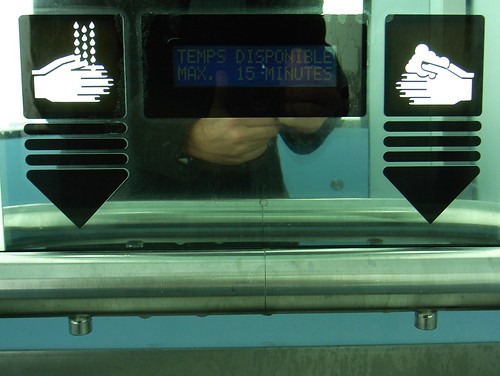Towards Touch-Free Spaces: Sensors, Software and the Automatic Production of Shared Public Toilets by Martin Dodge and Rob Kitchin is an essential read for anyone interested in how software-enabled technologies have implications at various spatial levels. In this case, it's about touching things with hands (pressing of buttons, pulling of handles, flicking switches, twisting selector dials), a relevant situation to understand the "nature of the recent automatic production of touch-free spatiality".
 (Toilet interface in Geneva)
(Toilet interface in Geneva)
Some excerpts that fascinated me:
"in spite of the hype and some potential benefits from touch-free technologies for enhanced convenience and hygiene, their real world implementation is always imperfect. The incomplete deployment of sensors and software across the sequence of activities (including opening doors) means that toileting as a whole can never be rendered fully touch-free and the bathroom fails to become a completely automated code/space. (...) Touch-free technology is almost always implemented partially, and also partial in different ways, which can make for user frustration as one is uncertain about how bits of an unfamiliar bathroom are meant to work: ‘so where do I wave my hands to get some soap?’. (...) The danger is then that toileting is set to become an over-determined activity. Attempting to make avowedly simple activities touch-free with digital sensors and software algorithms is simply unnecessary it could be argued, and an excess of automation in the bathroom could be critiqued as an example of disciplining the body through ‘technological paternalism’ "
Why do I blog this? Being interested in the usage of digital technologies in various places as well as the implications of automation, this is a good example of how to explore a specific locus of interaction.